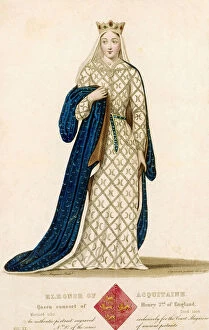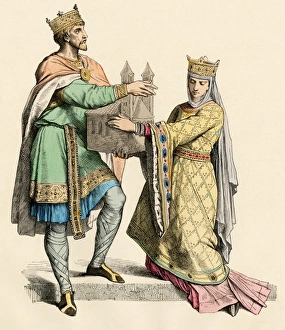Eleanor Of Aquitaine Collection
"Eleanor of Aquitaine: A Powerful Queen and Iconic Figure in Medieval History" This captivating engraving from 1809 portrays Eleanor of Aquitaine
All Professionally Made to Order for Quick Shipping
"Eleanor of Aquitaine: A Powerful Queen and Iconic Figure in Medieval History" This captivating engraving from 1809 portrays Eleanor of Aquitaine, the remarkable queen who left an indelible mark on European history. As the consort of Henry II of England, she wielded immense influence and power during her reign. The late 14th-century scenes depicted in the Chronique de St Denis further highlight Eleanor's significance as a medieval queen. Her regal presence is evident as she stands alongside kings and queens of France, symbolizing her role as a key figure in European politics. Henry II's effigy at Fontevrault showcases their union, emphasizing their shared rule over England. This engraving serves as a testament to their formidable partnership that shaped the course of English history. Eleanor's individuality shines through in various portraits throughout history. The 1838 engraving captures her timeless beauty and strength, reflecting her enduring legacy even centuries later. One pivotal moment was Eleanor's divorce from Louis VII, depicted vividly in the chromolitho artwork titled "The Divorce of Eleanore of Aquitaine and Louis VII. " This event marked a turning point for both Eleanor and Europe itself. Another intriguing portrayal comes from John Leech's c1860 artworks. In "Prince Arthur requires his Grandmother to surrender, " we witness Eleanor's commanding presence even within her own family dynamics. Similarly, "Queen Eleanor and Fair Rosamond" explores the complexities surrounding love affairs that were intertwined with political intrigue during this era. Lastly, we are reminded of Queen Eleanor through the exquisite effigy dating back to the 13th century. Preserved since then, it serves as a poignant reminder not only of her physical existence but also her lasting impact on society. Eleanor of Aquitaine remains an iconic figure whose story continues to captivate historians and art enthusiasts alike.















